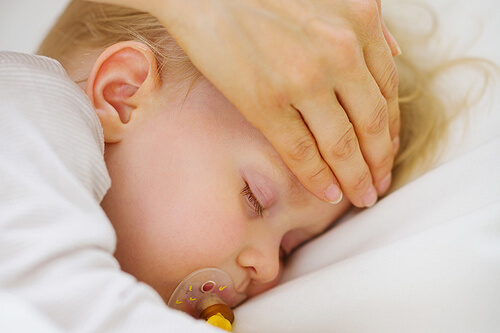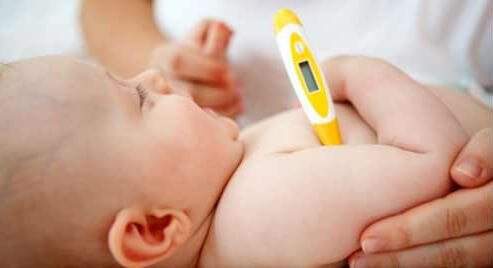Tips for Lowering a Child's Fever

In this article we’ll provide tips on how to help lower your child’s fever. Children frequently have fevers because their bodies have to fight a multitude of agents to create antibodies that adults already have.
Fevers create an increase in body temperature that mimics the natural reaction to certain diseases or infections.
We know whether someone has a fever with the help of a thermometer. If the temperature is around 99 degrees Fahrenheit, the temperature is higher than normal. In this case, you must try to lower your child’s fever as soon as possible.
Of course, you should see a doctor if your child has any of the following symptoms in addition to a fever:
- Cough or phelgm
- Vomiting or diarrhea, or on the contrary, no urination or bowel movement
- Pale skin
- Inactivity
- Rash on the skin
- No appetite
How to treat a child’s fever
Below you’ll find a number of remedies to help lower a child’s fever as soon as possible:
Give him a warm bath
To lower his body temperature, you can draw him a warm bath. Fill the bathtub with water that is 98 degrees Fahrenheit. This way, the child will enter water that is the same as his normal body temperature.

It’s ideal to keep him in the bath until the water gradually cools off, so he’ll also cool down and relax.
Cool the forehead, neck, legs and hands
It’s recommended to use a wet cloth or compress with room-temperature water. Use it on the forehead, hands, legs and neck.
This is a way to cool off a child without needing to bathe him in case he’s too tired and doesn’t want to move. This is also a very good option during winter.
As the compresses warm up, it’s good to wet them again and reapply them. This can be repeated until you use a thermometer to see that your child’s fever has decreased.
Create a good room temperature
It’s important to regular the temperature in your child’s room so it’s not too cold or too hot. It’s also advisable to ventilate the room to provide fresh air.
If it’s dinner time and you use an air conditioner or fan, be careful not to expose the child directly to the vents. It’s preferable to be further away so that only a gentle breeze is felt.
Remove some clothes
You must lower the child’s body temperature to prevent the fever from increasing. It’s ideal to remove a layer of clothing in winter or make sure your child is as cool as possible in summer.
Another option is to take off the child’s shoes and leave his feet in the open air.
If it’s too hot outside, try to have his feet make contact with a cold surface, whether a floor, a wet cloth or a bowl of water, depending on the child’s age and what is most comfortable.
Avoid dehydration
The child will begin to sweat and lose his appetite as soon as he has a fever, so you have to try to always keep him hydrated.
It’s always recommended that children drink a lot of fluid in order to reduce a fever. Good choices include water, juice or some warm soup in winter.

Rest and more rest
Finally, the best cure for a child’s fever is rest and more rest. Many children are tired and don’t feel like playing when they have a fever.
However, there are others who aren’t aware of their body temperature when they have a fever and therefore play and run as they usually do.
It’s recommended that they stay calm and do activities that don’t require much effort, such as watching a movie or reading a book.
If the child is younger than 3 months old, you must take him to the doctor as soon as possible and not wait for the fever to go down at home.
And remember…
Fever is an illness and, as such, a doctor must determine a diagnosis in case any treatment is to be administered.
You should never medicate your child without being told to do so by a specialist. Making decisions on your own can endanger your child’s health.
If, after putting these tips into practice, you see that your child’s fever hasn’t lowered or has even gone up, immediately go to your pediatrician for counsel.
You should also seek medical help when a fever lasts more than two consecutive days.
In this article we’ll provide tips on how to help lower your child’s fever. Children frequently have fevers because their bodies have to fight a multitude of agents to create antibodies that adults already have.
Fevers create an increase in body temperature that mimics the natural reaction to certain diseases or infections.
We know whether someone has a fever with the help of a thermometer. If the temperature is around 99 degrees Fahrenheit, the temperature is higher than normal. In this case, you must try to lower your child’s fever as soon as possible.
Of course, you should see a doctor if your child has any of the following symptoms in addition to a fever:
- Cough or phelgm
- Vomiting or diarrhea, or on the contrary, no urination or bowel movement
- Pale skin
- Inactivity
- Rash on the skin
- No appetite
How to treat a child’s fever
Below you’ll find a number of remedies to help lower a child’s fever as soon as possible:
Give him a warm bath
To lower his body temperature, you can draw him a warm bath. Fill the bathtub with water that is 98 degrees Fahrenheit. This way, the child will enter water that is the same as his normal body temperature.

It’s ideal to keep him in the bath until the water gradually cools off, so he’ll also cool down and relax.
Cool the forehead, neck, legs and hands
It’s recommended to use a wet cloth or compress with room-temperature water. Use it on the forehead, hands, legs and neck.
This is a way to cool off a child without needing to bathe him in case he’s too tired and doesn’t want to move. This is also a very good option during winter.
As the compresses warm up, it’s good to wet them again and reapply them. This can be repeated until you use a thermometer to see that your child’s fever has decreased.
Create a good room temperature
It’s important to regular the temperature in your child’s room so it’s not too cold or too hot. It’s also advisable to ventilate the room to provide fresh air.
If it’s dinner time and you use an air conditioner or fan, be careful not to expose the child directly to the vents. It’s preferable to be further away so that only a gentle breeze is felt.
Remove some clothes
You must lower the child’s body temperature to prevent the fever from increasing. It’s ideal to remove a layer of clothing in winter or make sure your child is as cool as possible in summer.
Another option is to take off the child’s shoes and leave his feet in the open air.
If it’s too hot outside, try to have his feet make contact with a cold surface, whether a floor, a wet cloth or a bowl of water, depending on the child’s age and what is most comfortable.
Avoid dehydration
The child will begin to sweat and lose his appetite as soon as he has a fever, so you have to try to always keep him hydrated.
It’s always recommended that children drink a lot of fluid in order to reduce a fever. Good choices include water, juice or some warm soup in winter.

Rest and more rest
Finally, the best cure for a child’s fever is rest and more rest. Many children are tired and don’t feel like playing when they have a fever.
However, there are others who aren’t aware of their body temperature when they have a fever and therefore play and run as they usually do.
It’s recommended that they stay calm and do activities that don’t require much effort, such as watching a movie or reading a book.
If the child is younger than 3 months old, you must take him to the doctor as soon as possible and not wait for the fever to go down at home.
And remember…
Fever is an illness and, as such, a doctor must determine a diagnosis in case any treatment is to be administered.
You should never medicate your child without being told to do so by a specialist. Making decisions on your own can endanger your child’s health.
If, after putting these tips into practice, you see that your child’s fever hasn’t lowered or has even gone up, immediately go to your pediatrician for counsel.
You should also seek medical help when a fever lasts more than two consecutive days.
All cited sources were thoroughly reviewed by our team to ensure their quality, reliability, currency, and validity. The bibliography of this article was considered reliable and of academic or scientific accuracy.
- Fiebre: ¿qué hacer cuando el niño tiene fiebre? (s. f.). Recuperado 1 de enero de 2022, de Aeped.es website: https://enfamilia.aeped.es/temas-salud/que-hacer-cuando-nino-tiene-fiebre.
- Hospital Cruz Roja de Córdoba. (2017, octubre 31). ¿Cómo bajar la fiebre en bebés y niños? Recuperado 1 de enero de 2022, de Hospital Cruz Roja de Córdoba website: https://hospitalcruzrojacordoba.es/consejos-de-salud/como-bajar-la-fiebre-en-bebes-ninos-pediatria/.
- Oré Rodríguez, E. M., & Sulca Godoy, R. (2018). CONOCIMIENTO Y PRÁCTICA DE LOS PADRES SOBRE EL USO DE MEDIOS FÍSICOS PARA CONTROLAR LA FIEBRE EN NIÑOS ATENDIDOS EN EL SERVICIO DE EMERGENCIA DEL HOSPITAL SAN JUAN DE LURIGANCHO, 2017. Universidad María Auxiliadora.
- Fernández García-Abril C, Benito Gutiérrez M. Protocolo de intoxicación por paracetamol.
Protoc diagn ter pediatr. 2021;1:803-10. Disponible en: https://www.aeped.es/sites/default/files/documentos/56_intoxicacion_paracetamol.pdf. - Meremikwu M, Oyo-Ita A. Physical methods for treating fever in children. Cochrane Database Syst Rev. 2003;2003(2):CD004264. doi: 10.1002/14651858.CD004264. PMID: 12804512; PMCID: PMC6532675.
This text is provided for informational purposes only and does not replace consultation with a professional. If in doubt, consult your specialist.








